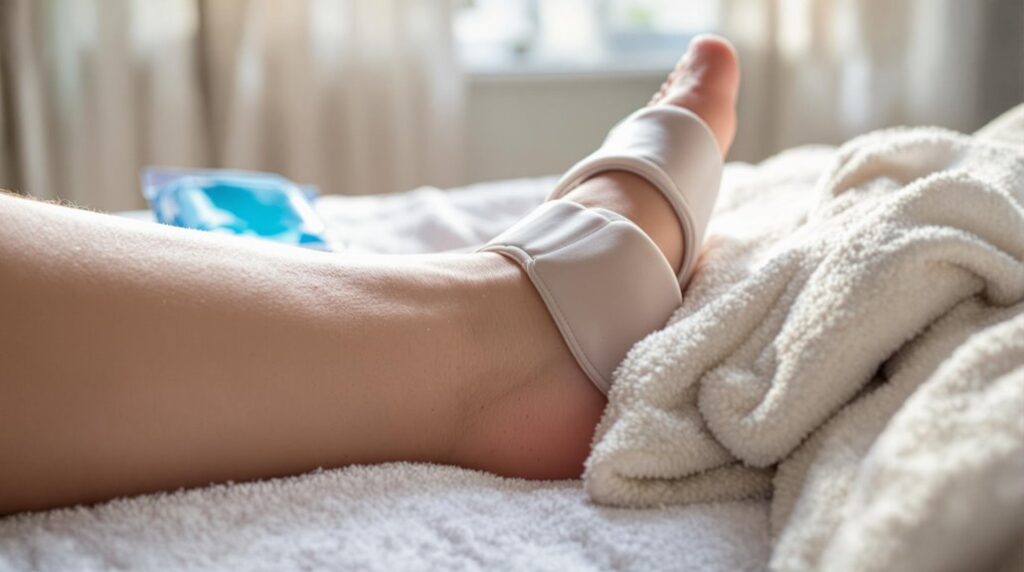To effectively manage a sprained ankle, you should start with ice therapy for the first 48 hours to reduce swelling and pain. Apply ice for 15-20 minutes every 1-2 hours. After 2-3 days, shift to heat therapy to relax muscles and improve circulation, using moist heat for best results. This combination of treatments enhances recovery. Maintaining a balance between ice and heat will optimize healing, and you can learn more about effective practices.
Understanding Sprained Ankles
A sprained ankle represents a common yet significant injury that many people encounter during physical activity. This injury occurs when the ligaments connecting the bones in the ankle joint get stretched or torn, often due to sudden twists, falls, or awkward landings. You might experience symptoms like swelling, pain, bruising, and difficulty bearing weight on the affected foot. Sprains are classified into three grades: Grade I involves mild stretching, Grade II indicates a partial tear, and Grade III signifies a complete tear of the ligament. Understanding these distinctions is vital for evaluating the severity of your injury. Recovery time varies, with mild sprains healing in days to weeks, while severe injuries may require several weeks to months for full recovery.
The R.I.C.E. Method for Initial Treatment
When you experience a sprained ankle, implementing the R.I.C.E. method—Rest, Ice, Compression, and Elevation—can greatly aid in your recovery. First, resting the injured ankle prevents further damage and kickstarts the healing process. Next, applying ice for 15-20 minutes every 1-2 hours during the initial 48 hours helps reduce swelling and numbs pain. Additionally, using an elastic bandage for compression stabilizes the ankle and prevents fluid buildup, further minimizing swelling. Finally, elevating your ankle above heart level enhances blood flow and reduces swelling, promoting faster recovery. By following these four steps, you can effectively manage your sprained ankle and set the stage for a smoother rehabilitation process.
The Role of Ice Therapy
Ice therapy plays a critical role in managing a sprained ankle, especially during the first 48 hours following the injury. By reducing blood flow to the affected area, ice helps minimize swelling and pain. For best results, apply ice for up to 20 minutes at a time, multiple times a day. Always use a protective layer, like a towel, between the ice and your skin to prevent ice burns. Ice therapy also induces local anesthesia, numbing the area and reducing muscle spasms related to the sprain. Incorporating ice therapy into the R.I.C.E. method—Rest, Ice, Compression, Elevation—is essential for effective recovery, ensuring you address inflammation and discomfort promptly to facilitate healing.
Transitioning to Heat Therapy
After the initial 2-3 days of ice therapy, shifting to heat therapy becomes vital for further recovery of a sprained ankle. Once swelling has notably decreased, applying heat can help relax your muscles and improve circulation in the affected area. This increased blood flow is particularly beneficial for alleviating stiffness and promoting healing. Moist heat, such as warm baths or heating pads, tends to enhance the effectiveness of heat therapy compared to dry heat. When using heat, apply it for 15-20 minutes at a time, ensuring the temperature remains comfortable to avoid burns. Incorporating heat therapy into your daily routine after the acute phase can further aid in restoring flexibility and range of motion, essential for a complete recovery.
Combining Ice and Heat for Optimal Recovery
Combining ice and heat therapy can greatly enhance the recovery process for a sprained ankle. Start with ice therapy for the first 2-3 days to minimize swelling and pain; apply ice for 15-20 minutes multiple times a day. This helps reduce inflammation immediately after the injury occurs. Once the swelling subsides, switch to heat therapy for 15-20 minutes to relax muscles and improve circulation, which aids healing. Alternating between ice and heat, known as contrast therapy, can effectively manage pain and promote recovery by enhancing blood flow while preventing prolonged swelling. Always use a barrier, like a towel, to protect your skin from burns during both treatments, ensuring safe and effective recovery.
When to Seek Professional Help
Knowing when to seek professional help after a sprained ankle is essential for ensuring proper recovery and preventing further complications. If you notice persistent pain and swelling after 48 hours of employing the R.I.C.E. method, it's wise to consult a healthcare provider to rule out fractures. Significant bruising, inability to bear weight, or visible deformities also warrant immediate medical attention, as these symptoms may indicate serious conditions. Should your ankle remain swollen after a week of home treatment, professional evaluation is necessary to assess for ligament damage. Additionally, if you experience ongoing instability or a sensation of your ankle "giving way," a medical professional can recommend rehabilitation or imaging tests. Those with underlying health issues must seek prompt advice post-injury.


